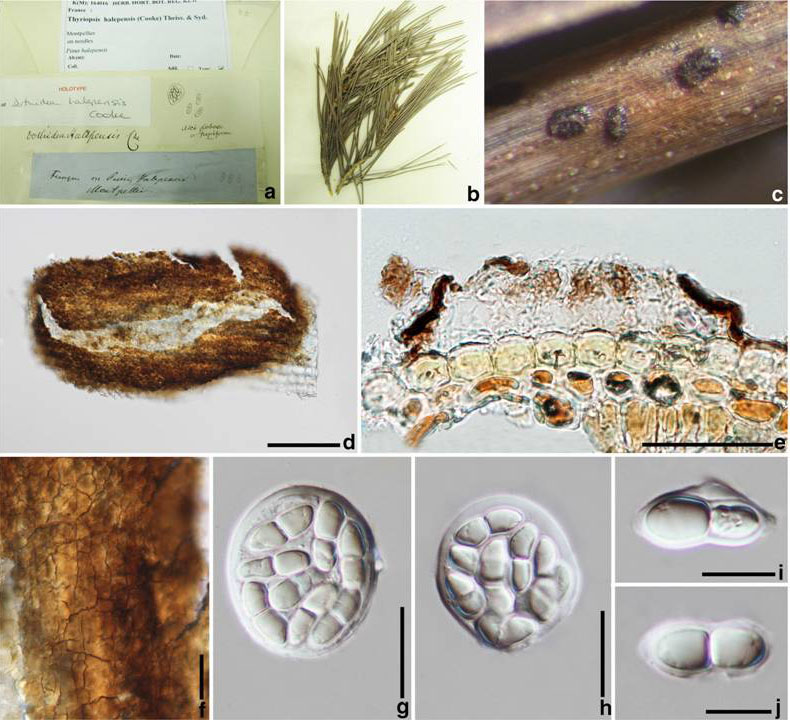Thyriopsis halepensis (Cooke) Theiss. & Syd., Annls mycol. 13(3/4): 369 (1915).
≡ Dothidea halepensis Cooke, Grevillea 7(no. 41): 35 (1878)
≡ Phyllachora halepensis (Cooke) Cooke, Grevillea 13(no. 67): 70 (1885)
= Aulographum acicola Harkn., Bull Calif. Acad Sci. 1: 47 (1884–1886)
= Lembosia acicola (Harkn.) Sacc., Syll. fung. (Abellini) 9: 1107 (1891)
MycoBank number: MB 144221; IndexFungorum number: IF 144221; Facesoffungi number: FoF 11883;
Type: K 164016.
Saprobic on pine needles, forming blackened spots on the surface. Superficial hyphae not observed. Sexual state: Thyriothecia 100–250μm diam, scattered or sometimes in linear rows, subcuticular, flattened, opening by linear fissures, sometimes Y-shaped, composed of the yellow to brown loose cells, easily broken. Peridium at the side composed of dark brown elongate cells, upper layer dissolving to release asci which are vertical in the thyriothecium. Hamathecium lacking pseudoparaphyses. Asci 57–60×48–53μm (x = 57×52μm, n=10), 8-spored, bitunicate, thick-walled, globose to obovoid, lacking a apedicellate. Ascospores 22–27×8–11μm (x = 25× 10μm, n=10), fasciculate, ellipsoidal, 2-celled, cells of roughly equal size, rounded at the ends, highly constricted at the septum, hyaline, some yellowish-brown. Asexual state: Pycnidia black, amphigenous, subcuticular, roundish to elongate, covered with a layer of isodiametric, brownish, thick-walled cells, opening by fissures. Conidiophores originating from a thin layer of hyphae next to substratum, hyaline, cylindrical to obclavate, from 15–30×1.5–3μm, becoming septate. Conidia hyaline, oval to cylindrical (von Arx and Müller 1975).
Material examined: FRANCE, Montpellier, on needles of Pinus halepensis Miller (Pinaceae), (K 164016, holotype).
Fig. 1 Thyriopsis halepensis (holotype). a, b Description and herbarum specimen. c Appearance of thyriothecium on the stem of needles. d Squash mount of thyriothecia. e Vertical sections through thyriothecia in cotton blue reagent. f Wall of thyriothecium. g, h Asci. i, j Ascospore. Scale bars: d=100μm, e=50μm, f–h=20μm, i, j=10μm

